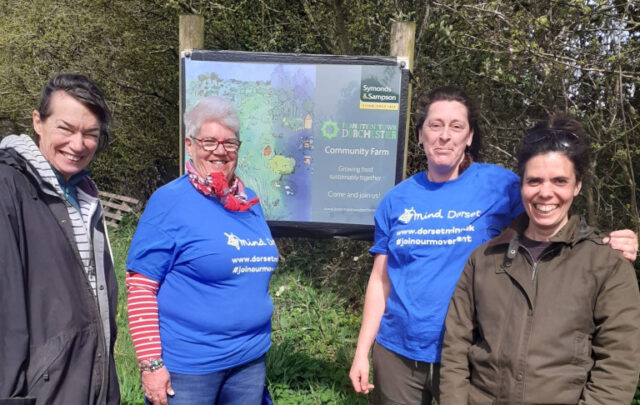 Atina and Martin Diffley watch developers’ bulldozers alongside their cornfield in Eagan, Minn
Atina and Martin Diffley watch developers’ bulldozers alongside their cornfield in Eagan, Minn
(t.l. gettings for rodale institute)Many journalists go into their line of work wanting to tell stories that will help fix the world, make something broken whole again. I have been writing about the environment, agriculture, city planning, and sprawl for much of my career—and I know that I, too, am trying to restore a lost world.
I grew up in the 1970s and 80s in Eagan, Minn., near an unusual farmer who worked a remarkable piece of land. The young Martin Diffley grew an array of vegetables on fields tucked amid grassy, protective hills and dense woods, a landscape much different from the deforested, monoculture farms so common in the region. Diffley established his Gardens of Eagan, one of the first organic farms in the Midwest, on land that had been owned by the Diffley family since 1855; pesticides and other common agricultural chemicals had never been used on it. But its edenic traits could not save it. In the late 1980s, as the Twin Cities oozed into the countryside around it, the forests were bulldozed and the hills flattened to make way for unimaginative houses in various shades of beige.
The story behind the loss of that place forms the broken heart of Turn Here Sweet Corn (University of Minnesota Press), a new memoir by Atina Diffley, Martin’s wife. The book is billed as a gardening guide, love story, business handbook, and legal thriller, but it is really a wrenching tale of a common yet private tragedy: the way development pressures push farming families off the land, and what happens to those families during and afterward.
Atina Diffley comes from Midwestern farming stock I recognize—a family in which strong women and children hold the farm together and get the work done, while the men escape. After a few years of idealism, a failed marriage, and some missteps, she settles down with Martin in Eagan as a single mom, falling in love with not only the man but also the land. Its places, named by the family, give it almost a mythical quality: the Plains of Abraham, the Big Oak Woods, Treasure Hill, the Crown Jewel, and the Bridge Ravine, where 10-year-old Martin once chopped down a tree to span the ravine. Martin and Atina lie in the grass while he talks about Eagan’s old-timers and their history there.
“I had always thought the expression ‘good connections’ meant knowing people in high places,” Atina writes, “but it’s the clerk in the grocery store, the farmer down the road with manure, the teller at the bank. This is what creates a secure community.”
By the time Atina arrives, the old Eagan is already being dissolved. Farmers like the Diffleys are being replaced by an exclusive, aspirational wealth that would make homes and property in Eagan among the most expensive in Minnesota by the mid-1990s. (Tim Pawlenty, the state’s former governor and a Republican presidential candidate, got his start in politics on the Eagan Planning Commission and City Council after moving to his “dream home” there in the mid-1980s.) As developers buy up farms, Atina describes the local heartbreak—like the elderly farmer’s wife at a household auction whose hands tremble as she holds up family china that no one wants to buy. In another scene, Atina takes her daughter to dance class at the new elementary school built on their land, passing by a huddled group of suburban moms who mutter about how dirty Atina is. Her writing is poetic, as if she yearns to make something beautiful out of her tribulations, but you sense a smoldering anger underneath it all.
What she does not convey as often is a broader sense of what was lost. Turn Here Sweet Corn , named for a sign in front of the Diffley’s farmstand on Highway 3, shares its title with a 1991 documentary by Helen De Michiel, which captured the Diffleys around the time the development was beginning. The film pointed to the dangers of paving over prime farmland near the city. Should gas prices rise, or long food-supply chains become unstable, the Twin Cities would need a diversified, productive farm like the Diffleys’.
At a picniclike wake for the land, documented in the film and briefly in the book, a young relative of Martin, who works in economic development, says that the land gave the Diffleys an opportunity to farm and feed people, and now it will provide an opportunity for the hundred or so families that will buy dream homes. In a scene left out of the book, Martin calls her out. “Let’s put that in perspective: Their ‘opportunity’ is owning a $300,000 home,” he says. “I would say that in 10 years from now if … it goes kaput, they would say, ‘Man, that was an organic farm, and we have got $300,000 white elephants on there.'”
I knew nothing about the land’s value in those terms when I was a kid. My grandfather built our house near the Diffley property in 1975, and the farm was a place for a friend and me to go adventuring, to learn about the beauty and perils of the woods, or even to encounter decay and death—like the deer we saw reduced to bones over time, and the dog (or was it a coyote?) we found lying in the tall grass, its guts spilled out. An abandoned wagon, an old house foundation, or antique discarded junk in the Bridge Ravine gave a sense of history in a suburbanizing city eager to wipe away its past.
Looking back now, I can appreciate how lucky I was to live near the Diffleys. In his lauded book, Last Child in the Woods, Richard Louv laments that kids today grow up in sterile indoor settings—a condition, he asserts, that stunts their emotional and intellectual growth. To be able to roam unsupervised, and to negotiate my own relationships with the landscape, gave me a greater sense of independence as an adult. It was a gift that my own children, who are growing up in a more monitored, urban environment, may not experience.
Ironically, our families were the first of a wave that would push the Diffleys off of their land, and I was a trespasser. Martin Diffley, with his bushy mustache and thick black hair, was a mysterious, intimidating figure to us kids (I did not know Atina, as far as I can remember), but he was gracious. He hired us to pick vegetables, perhaps to keep us out of trouble. One day when I turned up for work, he took me out to the Plains of Abraham. We sat down in the field and he cut into a ripe melon with a pocketknife. Squatting in the dirt, he talked about the connection between the land, a person’s health, and the food grown there. He commented on the fallout from the jet contrails overhead, the environmental repercussions of my father’s work selling lawn fertilizer, and the legacy of that place, increasingly hemmed in by vinyl-clad boxes.
He was one of the first to make those kinds of connections explicit for me, and as an adult I have thought about him often. Directly or indirectly, he inspired me to tear out my front lawn to plant a vegetable garden when I bought a house in a 1930s suburb—also built on land that was once a majestic farm. When the garden caused a minor scandal that landed me in the local media, I told the neighbors who wanted “traditional” landscaping that I was merely returning the land to its traditional use.
In the late 1980s, I was a teenager distracted by other problems when the Diffley land was bulldozed, and I never knew what happened to them. Atina Diffley’s book tells how the couple started over. They bought a dilapidated, rat-infested farmstead 20 miles south of Eagan and burned it to the ground. (It was a simple financial calculation: a $35,000 bill for demolition versus a $300 fine for burning without a permit.) But the land in the area was the real attraction. “The soil in the neighbors’ fields is so black, the gopher mounds look like giant chocolate drops,” Atina writes.
While 150 years of experience and lore guided the Diffleys’ farming in Eagan, she and Martin needed to form a new relationship with that soil—a realization that hit her as she was washing off the dirt one night. In Eagan, the sandy soil settled to the bottom of the tub, while on the new land, “the higher clay content of the loam soil stays suspended longer, making the water satiny,” Atina writes. The soil composition would affect, among other things, how the fields absorbed water and how soon the Diffleys could work after a rain—an indication of the complexity of organic farming. “Here I am, lying exhausted in a hot bath, at the end of a long and muddy day, studying the dirty water. Lots of things are going to be different here.”
But pressures from development would remain, culminating in their biggest fight: In 2006, Koch Industries, through eminent domain, sought to put a pipeline directly through their new farm—an intrusion that would pit “soil versus oil,” as the slogans around the battle put it. There, the “good connections” that Atina pondered in the grass would become key.
To reveal how things turned out would ruin Turn Here Sweet Corn‘s legal-thriller billing. Suffice it to say that a yearning for permanence is a theme throughout the book, as one force displaces another. American Indians make way for Irish farmers, who make way for exurban climbers, and so on.
Atina and Martin are part of the cycle, as indicated in a haunting scene after they take over their new farm. One night a pack of coyotes circles the house, baring teeth and yowling—”a torrent of falsetto stabs that pulsates through our bodies,” Atina writes.
“This was their wild place. They are furious at our invasion. Circling the enemy is an intimidation tactic. … We have been pushed out of Eagan by the bulldozers, and in chain reaction we are now encroaching on the coyotes’ territory. We are the intruders.”





